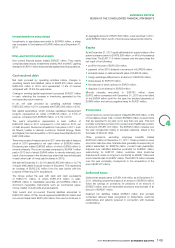APC 2011 Annual Report Download - page 146
Download and view the complete annual report
Please find page 146 of the 2011 APC annual report below. You can navigate through the pages in the report by either clicking on the pages listed below, or by using the keyword search tool below to find specific information within the annual report.
144 2011 REGISTRATION DOCUMENT SCHNEIDER ELECTRIC
4TRENDS IN SCHNEIDER ELECTRIC’S CORE MARKETS
BUSINESS REVIEW
>
1. Trends in Schneider Electric’s core
markets
Industries and machine manufacturers
The industry and machine manufacturers markets continued to
grow signifi cantly in 2011, in the continuity of the sharp rebound
experienced since the economic cycle trough in May2009.
The dynamics during the year changed though, from a buoyant
start of year, somewhat amplifi ed by the Fukushima earthquake
(customers anticipating orders for fear of electronic components
shortages), towards a weaker second semester, when the OEMs
(original equipment manufacturers) sector in North East Asia (China,
Korea, Taiwan, Japan) was affected by the tight credit policy led by
China government to curb infl ation. However, China infrastructure
and mining sectors continued to grow.
Investments in Western Europe were as well impacted in the second
part of the year, due to the uncertainty generated by the sovereign
crisis, while the US markets enjoyed a relative resilience, notably in
the last fourmonths of the year.
Beyond these regions, very positive evolution of emerging markets,
such as South and Central Americas, Russia, South East Asia,
driven by water and mining investments.
The political events in the Mediterranean countries affected the
investments and projects, notably those linked to Water (Egypt,
Lybia). In the rest of the world, the standardization of the water
treatment plants and a more comprehensive management of
the whole water cycle in large urban environments sustained the
investments.
The mining , minerals and metals sectors grew substantially this year,
with signifi cant investments in countries such as Brazil, Canada,
Russia, and, in the later part of the year, also in Australia, driven
both by the increased consumption of raw materials and a concern
to control and reduce energy consumption.
Non residential buildings
In the US, non-residential construction declined on an annual basis,
but experienced signs of sequential improvement starting during the
second semester. Front runners were healthcare, private education,
retail and manufacturing buildings. European countries suffered
from the sovereign debt crisis and austerity measures. In new
e conomies, the non-residential construction market experienced a
dynamic activity generated by the powerful process of urbanisation.
Schneider Electric solutions and services are designed to monitor
and control system for buildings effi ciency. Our solutions integrate
access control, video surveillance, HVAC, and lighting control on
an open standard systems to maximize buildings effi ciency by
improving the energy consumption and safety of a building.
In 2011, Schneider Electric has reinforced its Building Energy
and Occupancy Management offer with the integration of Vizelia
and D5X. Schneider Electric has also acquired Summit Energy, a
Strategic Energy Sourcing leader and Viconics, offering an exciting
suite of wireless thermostats.
Residential
In the US, residential construction market sector was negatively
impacted notably by low consumer confi dence and tight lending
conditions. However, starts of multi-family housing has improved
throughout the year, from a very weak level.
In the Eurozone, after a harsh fall of output between 2008 and
2010, the residential market has slightly improved in 2011. Note
that this trend is characterized by large disparities across countries.
On one hand, Iberian countries are still undergoing strong decline
in investment and facing high levels of outstanding inventories.
Meanwhile, countries such as France are in an intermediate pace
essentially thanks to the support of new housing construction. On
the other hand, Germany and Scandinavian countries have been
far less affected by the debt crisis with a housing market which is
even growing. In Asia Pacifi c, residential construction was relatively
fast growing. In Japan and New Zealand, the end of the year
was marked by large fl ows of reconstruction due to earthquakes
destructions. Finally, in new economies, positive demographic and
urbanisation trends drove the housing constructions.
























